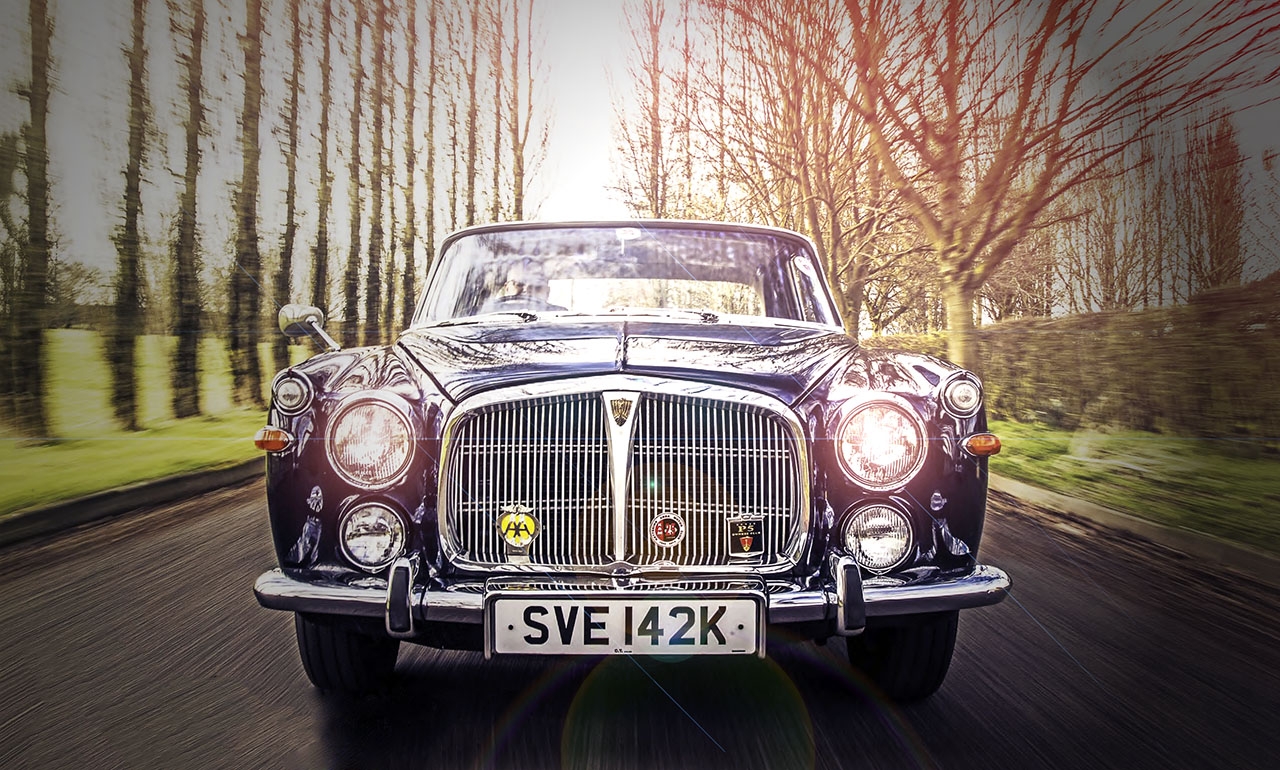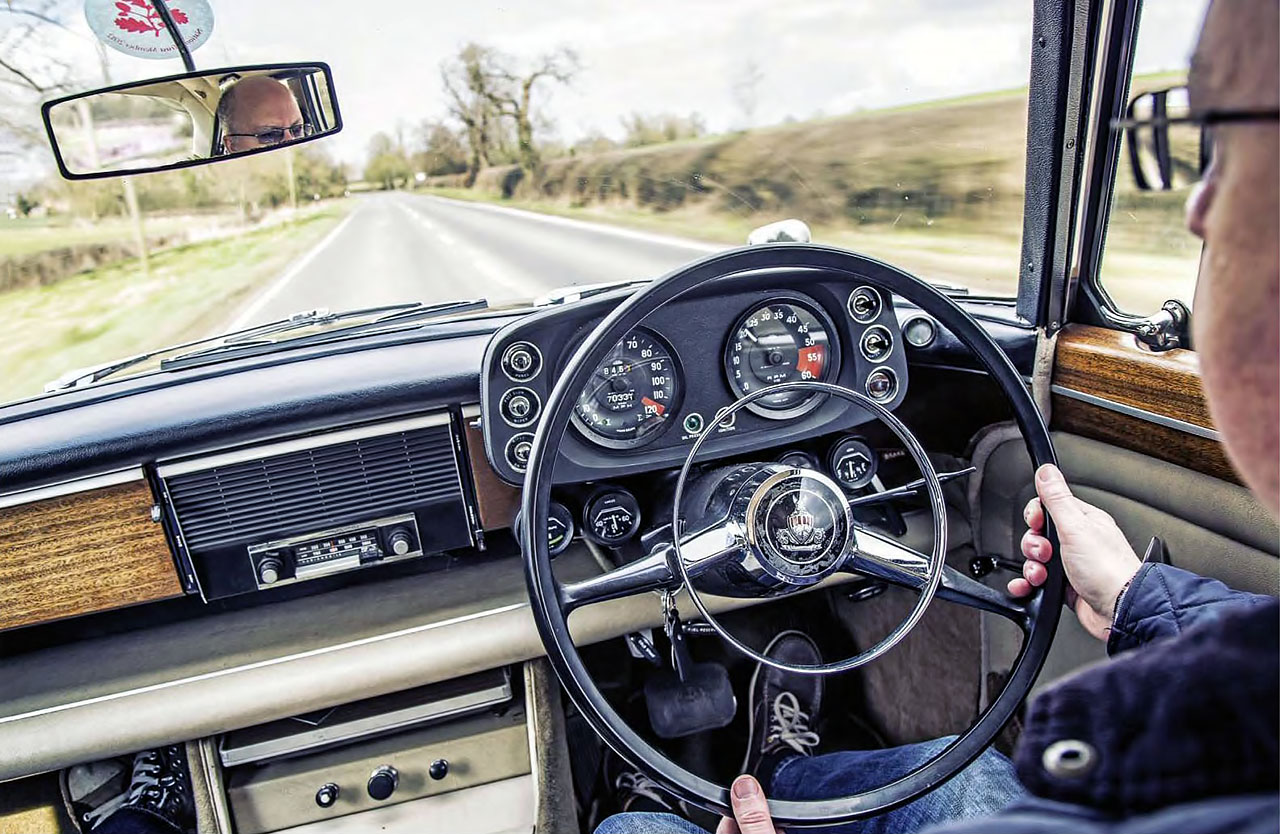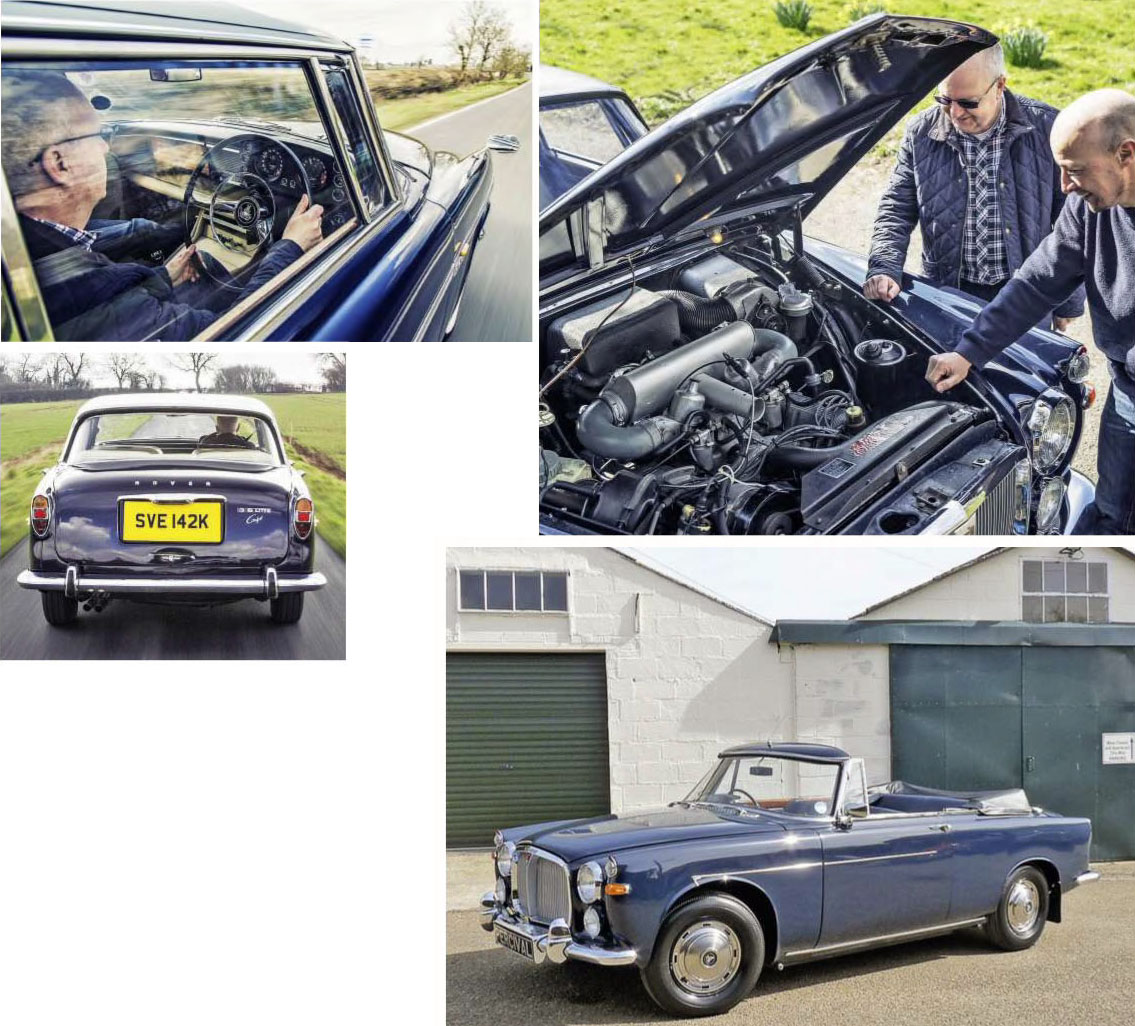
The List. Sixties cabinet ministers insisted on it, Richard Burton drove one while playing a gangster and it’s reader Stuart Grainger’s dream drive. So what did he make of the Rover P5B coupé? ‘What other car offers so much class for the money?’ Reader Stuart Grainger gave us his top ten classic must-drives. In return we gave him the keys to one of them for the day – a Rover P5B Coupé. Words Ben Field. Photography Richard Pardon.

The Rover P5B’s rumble sounded just right for Stuart’s ears.
STUART GRAINGER HIS WISHLIST
Stuart’s classics have included a Triumph Spitfire (‘pretty but a harsh ride’), a Citroën GS Pallas (‘great when it worked’) and a Fiat X1/9 (‘sublime handling’). His Mercedes 300 SL was a ‘motorised sofa’ and his current TR6 is ‘worth driving just for its noise in tunnels’.
Lancia Aurelia B20GT
No modern car maker would have the guts, or the guile, to slice two inches out of the roofline of a saloon and call it a coupé. But that’s what Rover did to its P5 saloon in 1962. The bold move turned an upright and stately conveyance of ministers and company directors into a rakish rival – in looks at least – to a Jaguar. And when Buick’s 3.5-litre V8 settled in beneath the bonnet a few years later, the resulting P5B – especially the Coupé – made buyers take a fresh look at staid old Rover.
In the P5B Coupé, fi lm makers in the popular gangster groove saw an alternative to the standard-issue Jag. Vic Dakin (played by Richard Burton) drove one in 1970’s Villain and it’s this outing that Classic Cars reader Stuart Grainger associates with the P5B Coupé more than anything else. ‘The first thing most people say about the P5B is how they were used to ferry prime ministers about,’ he says. ‘For me, it’s always Richard Burton in Villain.’
Philip Copperwheat’s P5B Coupé isn’t in the grey body/black roof finish of Dakin’s car, but to Stuart it’s in the right colours for a P5B Coupé. I think he’s right: dark colours make the body look even more substantial against that slip of a roof, finished in a shade so close to the colour of the sky that it’s barely visible. ‘The Coupé is much sharper looking than the saloon,’ says Stuart. ‘It has loads of kerb appeal and, back in the day, lots of showroom appeal too with its Rostyle wheels, two-tone paint and leather seats. What other car of the period offers so much class for the money?’
In his P5B Coupé Richard Burton mixed class with menace as Vic Dakin, even if the actor’s mellifluous voice struggled to adapt to the rigours of a rough and ready Cockney accent. There’s no such fakery from the P5’s Rover V8. ‘It makes exactly the right sound,’ says Stuart. ‘There’s a quiet, unstressed rumble at idle. Blip the accelerator and the rumble increases gradually and smoothly.’
Stuart settles back in the thick leather driver’s seat as owner Philip points out the controls. ‘It looks like someone sneezed out the controls and they were fitted where they landed,’ says Stuart in an honest appreciation of the melee of knobs and switches. But there’s no denting the overall experience of the sumptuous interior. ‘Despite the position of some controls, this car feels right,’ he smiles. ‘The seats are incredibly comfortable and there’s something about the thin steering wheel with its chrome-trimmed horn push. I get into some cars and feel instantly at home – the P5B is one of them.’
Stuart slips the lever from P to D, battles briefly to release the umbrella-type handbrake, and we’re off. The torque is such that Stuart barely needs to touch the accelerator to move the car up to the urban speed limit. After the static, on-the-drive enjoyment of the engine note, the getaway is rather subdued. No wonder the P5B was a favourite among politicians needing to discuss matters of state en-route, and fi lm villains in need of a stealthy getaway.
‘It’s equally at home on the open road as it would be rolling up outside Chequers’
‘It’s a very easy car to drive,’ notes Stuart. ‘A lot of the classics I’ve owned made much greater demands of the driver. My Capris, the XR3i, the Fiesta, the X1/9, were all great in their way, but they could never be described as relaxing drives. The closest I’ve had to the P5B Coupé in pure refinement would be my Eighties Mercedes-Benz 300 SL – even if it did look a bit Dallas, it was a great car. The only other car I’ve owned with a ride that even comes close to this for pure smoothness is a Citroën GS Pallas. It had an incredibly smooth ride, right up to the point when the suspension pipes burst. Then the ride got really bumpy, a bit like a plane coming in to land.’ As comparisons go, Stuart’s observations are plaudits indeed. The 300 SL was one of the best-engineered cars of its generation. As for the GS, its hydropneumatic suspension gave a legendary quality of ride – most of the time. And don’t forget the P5 arrived on the market with this mixture of refinement and ride quality in 1958. It would be churlish to mention that the DS, the GS’s ancestor, had been offering hydropneumatic cleverness to the world since 1955, while the P5 stuck to traditional torsion bars and leaf springs. We’re heading north to one of the UK’s best driving roads, and one that should well suit this wafting, powerful car. The B6047 stretches from Market Harborough up to Melton Mowbray. It’s full of long straights, sweeping bends and wonderfully swooping undulations. At weekends the road is a playground for bikers and sports cars. Midweek it’s empty save for the odd truck and delivery van. Smart B6047 fans turn back before busy Melton Mowbray.
Evidently the lure of the nation’s pork pie capital has created a traffic maelstrom guaranteed to boil even the best-behaved classic. We join the B6047 near East Langton. Just before the village there’s a long straight, a sort of warm-up area that’s been serving generations of keen drivers and riders. Stuart doesn’t need encouraging. ‘I love that throaty roar as the pedal goes down and the car gathers speed. It’s not quite as quick as I’d imagined in sheer acceleration; once you’re rolling, though, it goes really well.’
Between Church Langton and Tur Langton a series of bends gives the P5B a new challenge. ‘The Coupé was a bit roly-poly on the roundabouts earlier,’ says Stuart, ‘but on these long, fast corners it settles into a lean and stays there throughout the bend. As long as I keep my foot in it’s all right. The steering has a good amount of feel to it. Power-assisted steering boxes can be very vague, but this one could be mistaken for a rack. It’s that good.’
We take a break at Tilton, where the A47 bisects our B-road, and Stuart points the car on to a patch of gravel. ‘That sound, the wealthy crunch of gravel under the tyres, it’s the kind of thing many people associate with a car like this,’ says Stuart. ‘But the P5B is a superb touring car – it’s as equally at home on the open road at high speed as it would have been rolling up to Chequers at 10mph with a Prime Minister on board.’
Stuart and I swap seats and I’m instantly taken by just how much space Rover created by doing away with what had become a company tradition – an elaborate dashboard. In its place is a scooped-out expanse stretching almost to the windscreen. The sparseness of the dash area emphasises the modern-looking, angular instrument binnacle – a brave new world glimpsed through a traditional steering wheel.
There’s a solid, affirmative jolt as I select Drive and the car starts to creep forward with the smallest throttle input. Out on the road I can see what Stuart means about acceleration; it feels muted by the bulk of the car initially, but it doesn’t take long for the V8’s torque to take hold. The engine booms as it takes the strain of a long climb, dropping back to a murmur as the car rushes down the other side. Wind noise through the quarterlights is a greater intrusion into the cab than the sound of the V8 when it isn’t being worked.
When you do push hard it’s very easy to maintain high speed; the steering is sharper than it has a right to be and the disc/drum brakes stop the big car very quickly. At the end of our day with the P5B Coupé the car has definitely made it on to my own List – but is it still on Stuart’s? ‘My List would probably change every day,’ he replies, ‘but the P5B Coupé would always be on it.’
Thanks to: Philip Copperwheat, Rover P5 Club, Geoff Arthur, Peter Madden

‘It looks like someone sneezed out the controls and they were fitted where they landed,’ jokes Stuart. Off into the sunset – but definitely still on Stuart’s List.
‘I get into some cars and feel instantly at home – the Rover P5B is one of them’
THE EVOLUTION
1958 ROVER P5 3-LITRE SALOON
Rover’s first monocoque, the P5 is a bigger, better looking car than the P4 it is destined to replace. The engine is a 2995cc straight-six with 115bhp and the front suspension is independent. Automatic transmission with manual overdrive and Burman power steering are optional. Power steering is made standard in 1960. Rover’s new flagship quickly becomes a firm favourite with Cabinet ministers and senior business executives.
1962 ROVER P5 3-LITRE COUPÉ
Rover slices a couple of inches out of the roofline of the P5 saloon to create the P5 Coupé. Saloons and Coupé both get a Weslake cylinder head and a power increase to 134bhp. The P4 110 launched in the same year gets the same Weslake treatment and snaps at the P5’s heels with 123bhp. Hydrosteer, a much-maligned power steering unit that is fully integrated into the steering box, is an optional extra.
1967 ROVER P5B SALOON AND COUPÉ
Deemed too small for US tastes, Buick’s 3.5-litre all-alloy V8 is a perfect fit under the P5’s bonnet – and the P5B was born. With 161bhp it’s a lot more powerful than the straight-six and gives a 0-60mph time of less than 13sec. All ’Bs are automatic with Rostyle wheels and twin exhausts. Among the political heavyweights to use one were Margaret Thatcher, Harold Wilson, James Callaghan and Edward Heath. Queen Elizabeth II also has one.
TECH DATA 1971 ROVER P5 B COUPÉ
Engine 3528cc, V8, two SU HS6 1¾in carburettors
Power and torque 160bhp @ 5200rpm; 210lb ft @ 2600rpm
Transmission Three-speed automatic, rear-wheel drive
Steering Cam and roller
Suspension Front: independent, wishbones, torsion bars. Rear: live axle, semi-elliptic leaf springs Brakes Discs front, drums rear
Weight 2980lb (1352kg)
Performance
Top speed: 113mph;
0-60mph: 12.5sec
Cost new £2300
Value now £15,000
WANT A DRIVE?
Drive-My will make a dream drive happen for one reader in every issue. All you need to do to be in the reckoning is to send us your list of the ten cars you’d most want to drive, along with a CV of the classic cars you’ve owned to us. You’ll need to be prepared for the possibility of long-distance travel and an early-morning start, but you will enjoy an unforgettable experience.
IF ONLY THEY’D MADE MORE OF THEM SPECIAL-BODIED ROVER P5s
Rover sold only saloon and coupé editions of the P5, but it toyed with the idea of offering estate and convertible versions too.
In 1962 Pressed Steel was commissioned to build a P5 3-Litre estate and came up with a tough-looking load-lugger with an integral roof rack to hide a step in the roof over the cargo area.
To make the car as practical as possible there was a third row of seats in the back, which faced rearwards and folded flat into the floor when not in use. This allowed the Rover to carry eight people. It was a neat touch but meant relocating the fuel tank; there was now one on either side of the boot instead of one below the floor. This led to all sorts of running problems because of air locks in the pipe connecting the two tanks.
Shoddy build quality, huge conversion costs and awkward styling conspired to ensure the P5 estate never made it into production.
Rumour has it that two were built although only one was photographed by Rover. By July 1961 the project was officially canned, the prototype returning to Pressed Steel, with neither car (if there were ever really two) being seen again.
The following year Rover commissioned Chapron to build a P5 drophead. Once again it was based on a 1959 3-Litre. Rover had previously worked with Birmingham-based Mulliner and Salmons-Tickford on its special projects, but they were out of bounds after being swallowed up by Triumph and Aston Martin-Lagonda respectively.
As France’s foremost coachbuilder, Chapron was perfectly placed to come up with a beautiful open-topped P5 – and it didn’t disappoint. Created in time to make its debut on the Chapron stand at the 1962 Paris Salon, the MkI 3-Litre drophead coupé was a standard P5 forward of the windscreen. The bootlid was retained too, but the car was shortened and the rear seat narrowed to accommodate a soft-top that folded flush with the rear deck.
Rover agreed with Chapron that the car would return to the UK after its debut for use by Rover’s management. Chapron was forbidden from putting the car into production without Rover’s consent, but the car was registered in France (1601 MY 75) before disappearing. It’s rumoured that it went into a private collection in Switzerland, although it’s possible that this car was one of two 3-Litres unofficially converted by Graber, the first of which made its debut at the 1963 Geneva motor show and which was based on MkII edition.
‘A third row of seats folded flat when not in use and allowed the P5 estate to carry eight people’
Perhaps the best-known drophead P5 is the FLM Panelcraft-converted car recently sold by the Percival Motor Company. Commissioned by George Hansson in 1963 and registered 500 CBY, the car was sold in 1967 and it disappeared in the mid-Seventies. Found in 1994 and restored, the car is the only known survivor of all the special-bodied P5s.

This FLM Panelcraft car is one of few drop-top Rover P5s built. The 3.5-litre Buick V8 gave the P5 its commanding urge to match its presence.





